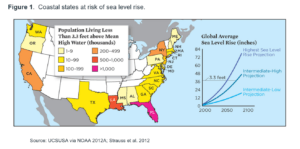Cancun: Is the Party Over?
The impact of rising sea levels on beachfront resorts.
The scientific community has warned about the impact climate change has on the world. Despite the potential consequences there is little agreement on potential solutions to this looming problem. The implications on various businesses are enormous. One such company that stands to be impacted by climate change is Apple Leisure Group’s subsidiary AMResorts (AMR), which is a hotel and brand management company with all-inclusive beachfront resorts in Mexico, the Dominican Republic, and numerous other locations in the Caribbean. AMResorts has contracts with over 60 properties and has a total of more than 22,000 rooms in 30 different destinations.[i]
By the year 2100, scientists have estimated that a global sea-level rise of 2.6 feet is likely and that up to 6.6 feet is possible depending on the effects of warmed air and ocean water on ice fields.[ii] Several island nations are already submerged or are at risk of being submerged while much of the world’s largest cities are also in danger of submersion given that they are in low-lying coastal areas.[iii] Recent trends indicate that the sea level in the Caribbean is rising at a similar level to the global average.[iv] This is a large economic problem as tourism is the largest economic sector in the Caribbean based on GDP and employment with international tourists bringing in more than $25 billion in the Caribbean and $3 billion to the Yucatan Peninsula in 2010.[v],[vi]
The impact of the above on AMResorts is clear: if the sea levels continue to rise as predicted much of their ocean front resorts will be submerged and thus the economic viability of the company is in jeopardy as rebuilding hotels on new coastlines is an expensive measure. To date, AMResorts has focused on achieving sustainable practice certifications with 25 of 60 properties certified in the Mexico and Caribbean, representing an expansion in the program of over 30%. To qualify, resorts must demonstrate a commitment to minimize environmental footprint while supporting local culture and the surrounding community. By participating in such a program, AMResorts is attempting to pull its own weight in curbing the root cause of climate change.
However, tackling the root cause of climate change takes a commitment larger than solely AMResorts as temperatures will likely continue to rise leading to a continued rise in sea levels. AMResorts should consider short term adaptations, perhaps in partnership with other resorts, to combat a rising sea level to maximize the longevity of their resorts. Such adaptations, including replacing eroded sand and building protective concrete walls, are unfortunately only temporary measures. Future resort plans should include planning for beach erosion by placing new resorts further back from the coast line to give the beaches room to move and rise. In addition, AMResort should enhance awareness with clients to bring attention to the issue of the rising sea level on the places that are often beloved by visiting tourists. The problems of climate change extend far beyond the AMResorts, and a global effort is necessary to help combat such issues.
Word count: 680
References:
[i] “AMResorts Development Chart” (PDF). AMResorts Media Site. July 11, 2016. Retrieved July 11, 2016.
[ii] Pfeffer, W.T., et al. 2008. Kinematic constraints on glacier contributions to 21st–century sea–level rise. Science 321(1340). doi:10.1126/science.1159099. Online at http://www.sciencemag.org/content/321/5894/1340.abstract.
[iii] Nell Greenfieldboyce, “”Study: 634 Million Pepople at Risk from Rising Seas,” National Public Radio, March 28, 2007.
[iv] Church, J. A., et al. 2004. Estimates of the regional distribution of sea level rise over the 1950–2000 period. Journal of Climate 17:2609–2625. doi:10.1175/1520–0442(2004)017<2609:EOTRDO>2.0.CO;2. Online at http://journals.ametsoc.org/doi/abs/10.1175/1520 0442%282004%29017%3C2609%3AEOTRDO%3E2.0.CO%3B2.
[v] World Travel and Tourism Council. 2004. The Caribbean: The impact of travel & tourism on jobs and the economy. London, UK. Online at http://www.caribbeanhotelandtourism.com/Publications_Studies.php. Cited in Simpson, M.C., S. Gössling, and D. Scott. 2008. Report on the international policy and market response to global warming and the challenges and opportunities that climate change issues present for the Caribbean tourism sector. Barbados: Caribbean Regional Sustainable Tourism Development Programme, Caribbean Tourism Organization. Online at http://www.caribtdp.org/index.php?Z=16
[vi] World Travel and Tourism Council. Travel and tourism economic impact 2011: Caribbean. London, UK. Online a: http://www.wttc.org/site_media/uploads/downloads/caribbean2.pdf.






Ryan thanks for this post! I totally agree with you, the impact of climate change on tourism is concerning and many people are not even aware of the effects this could bring to the Caribbean countries. In my opinion, the challenges resorts like AMR are facing are twofold. First, currently it is very hard to understand the relationship between climate change and tourist behavior. This fact can pose severe difficulties to not only resorts but the industry as a whole, making it hard to accurately forecast demand. The latter can result in either over or under investments in terms of infrastructure; which can not only harm the industry but also possibly exacerbate the impact of global warming. The second one relates to what you mentioned, the high costs of relocating resorts. In fact, it is estimated that this costs can reach $10-25 billion dollars by 2050 in the caribbean only (1). However, does not end there, a rise in sea-level can be even problematic for airports and roads impeding, in the short-term, the access of tourists and increasing, in the long term, the cost of making these resorts an option for families.
(1) https://skift.com/2014/03/31/how-climate-change-is-threatening-coastal-tourism-and-recreation/
Ryan, I thought your post was very interesting and It definitely hit a personal nerve for me, knowing how important tourism is for the Mexican Economy. One of Mexico’s best performing publicly traded companies over the past few years is Grupo Aeroportuario del Pacifico GAP, which operates the Cancun Airport. You can read a bit more about their performance here:
http://www.fool.com/investing/2016/10/19/grupo-aeroportuario-del-sureste-sab-cv-earnings-fl.aspx
If the resorts along the Mayan rivera are affected by rising sea levels, then GAP will likely be affected as well. The ripple effects of climate change are astonishing when we begin to dig a little deeper. Thanks for the thought provoking post!
Ryan – great post. With Cancun being a top travel destination in Mexico, I can only imagine the huge impact that a further rise in sea levels could have in the city’s (and country’s) economy. You made a really good point when you mentioned that AMResorts cannot tackle the issue of global warming alone. However, I would argue that it would take more than the private sector to convince the public of the importance of this issue. Given that the Mexican government would also be impacted by the decrease in tourism, I believe they should partner with companies like AMResorts, and together advocate for changes in regulation both domestically and abroad.
Great article, there’s definitely a real threat to these resorts near the equator. One other thing that perhaps goes without saying is that as temperatures continue to rise, tropical travel might venture further and further north. In other words, it may get too hot in locations around the equator for vacationers to be able to enjoy their time off — where will the Cancun of the future be? North Carolina? Even further north?
Very interesting post!
AMR case is especially interesting and complex because AMR is in a contradictory position, where its own activity negatively impacts its environment and hence threatens its future capability to operate. For example, most tourists visiting Cancun will reach the city by plane, with a huge carbon footprint impact. Then the activity of the resort itself is endangering its environment.
There are clearly three stakeholders here, each of them bearing a part of the responsibility: Mexican authorities, private tourism companies, and tourists.
I totally agree with the posts above that the impacts of climate change largely exceeds the private actors’ responsibilities and capabilities, and must be addressed in a partnership with the Mexican authorities. Tourists’ awareness must be raised both by tourism actors and authorities. The tourism actors must deploy all their possible efforts to reverse their negative impact on their environment. I also pragmatically think that they should preventively consider investing in other regions less impact by global warming on the short-term, to ensure future revenues.
I’ve found this study on global trends in coastal tourism interesting to push the reflexion further: http://www.responsibletravel.org/resources/documents/reports/global_trends_in_coastal_tourism_by_cesd_jan_08_lr.pdf
Thanks Ryan – very interesting to think about the rising sea levels on such a large Mexico city that relies on tourism.